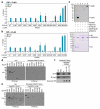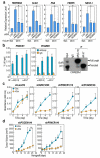lncRNA-dependent mechanisms of androgen-receptor-regulated gene activation programs
- PMID: 23945587
- PMCID: PMC4034386
- DOI: 10.1038/nature12451
lncRNA-dependent mechanisms of androgen-receptor-regulated gene activation programs
Abstract
Although recent studies have indicated roles of long non-coding RNAs (lncRNAs) in physiological aspects of cell-type determination and tissue homeostasis, their potential involvement in regulated gene transcription programs remains rather poorly understood. The androgen receptor regulates a large repertoire of genes central to the identity and behaviour of prostate cancer cells, and functions in a ligand-independent fashion in many prostate cancers when they become hormone refractory after initial androgen deprivation therapy. Here we report that two lncRNAs highly overexpressed in aggressive prostate cancer, PRNCR1 (also known as PCAT8) and PCGEM1, bind successively to the androgen receptor and strongly enhance both ligand-dependent and ligand-independent androgen-receptor-mediated gene activation programs and proliferation in prostate cancer cells. Binding of PRNCR1 to the carboxy-terminally acetylated androgen receptor on enhancers and its association with DOT1L appear to be required for recruitment of the second lncRNA, PCGEM1, to the androgen receptor amino terminus that is methylated by DOT1L. Unexpectedly, recognition of specific protein marks by PCGEM1-recruited pygopus 2 PHD domain enhances selective looping of androgen-receptor-bound enhancers to target gene promoters in these cells. In 'resistant' prostate cancer cells, these overexpressed lncRNAs can interact with, and are required for, the robust activation of both truncated and full-length androgen receptor, causing ligand-independent activation of the androgen receptor transcriptional program and cell proliferation. Conditionally expressed short hairpin RNA targeting these lncRNAs in castration-resistant prostate cancer cell lines strongly suppressed tumour xenograft growth in vivo. Together, these results indicate that these overexpressed lncRNAs can potentially serve as a required component of castration-resistance in prostatic tumours.
Figures




Comment in
-
Gene regulation: Long RNAs wire up cancer growth.Nature. 2013 Aug 29;500(7464):536-7. doi: 10.1038/nature12548. Epub 2013 Aug 14. Nature. 2013. PMID: 23945584 Free PMC article.
-
Long and noncoding RNAs (lnc-RNAs) determine androgen receptor dependent gene expression in prostate cancer growth in vivo.Asian J Androl. 2014 Mar-Apr;16(2):268-9. doi: 10.4103/1008-682X.122364. Asian J Androl. 2014. PMID: 24435053 Free PMC article.
-
Long noncoding RNA-mediated activation of androgen receptor in prostate cancer.Asian J Androl. 2014 May-Jun;16(3):418-9. doi: 10.4103/1008-682X.126398. Asian J Androl. 2014. PMID: 24713835 Free PMC article.
-
Re: lncRNA-dependent mechanisms of androgen-receptor-regulated gene activation programs.J Urol. 2014 May;191(5):1470-1. doi: 10.1016/j.juro.2014.02.011. Epub 2014 Feb 20. J Urol. 2014. PMID: 24745541 No abstract available.
References
-
- Heinlein CA, Chang C. Androgen receptor in prostate cancer. Endocr Rev. 2004;25:276–308. - PubMed
-
- Scher HI, Sawyers CL. Biology of progressive, castration-resistant prostate cancer: directed therapies targeting the androgen-receptor signaling axis. J Clin Oncol. 2005;23:8253–8261. doi:23/32/8253 [pii] 10.1200/JCO.2005.03.4777. - PubMed
-
- Petrovics G, et al. Elevated expression of PCGEM1, a prostate-specific gene with cell growth-promoting function, is associated with high-risk prostate cancer patients. Oncogene. 2004;23:605–611. doi:10.1038/sj.onc.1207069 1207069 [pii] - PubMed
-
- Chung S, et al. Association of a novel long non-coding RNA in 8q24 with prostate cancer susceptibility. Cancer Sci. 2011;102:245–252. doi:10.1111/j.1349-7006.2010.01737.x. - PubMed
Publication types
MeSH terms
Substances
Associated data
- Actions
Grants and funding
- R01 NS034934/NS/NINDS NIH HHS/United States
- R01 CA173903/CA/NCI NIH HHS/United States
- HHMI/Howard Hughes Medical Institute/United States
- DK18477/DK/NIDDK NIH HHS/United States
- T32 DK007541/DK/NIDDK NIH HHS/United States
- R01 DK018477/DK/NIDDK NIH HHS/United States
- R01 DK039949/DK/NIDDK NIH HHS/United States
- R00 DK094981/DK/NIDDK NIH HHS/United States
- R00 CA166527/CA/NCI NIH HHS/United States
- CA173903/CA/NCI NIH HHS/United States
- K99 DK094981/DK/NIDDK NIH HHS/United States
- 1K99DK094981-01/DK/NIDDK NIH HHS/United States
- 4R00CA166527-02/CA/NCI NIH HHS/United States
- R37 DK039949/DK/NIDDK NIH HHS/United States
- DK039949/DK/NIDDK NIH HHS/United States
- P30 CA023100/CA/NCI NIH HHS/United States
- NS034934/NS/NINDS NIH HHS/United States
LinkOut - more resources
Full Text Sources
Other Literature Sources
Molecular Biology Databases
Research Materials

